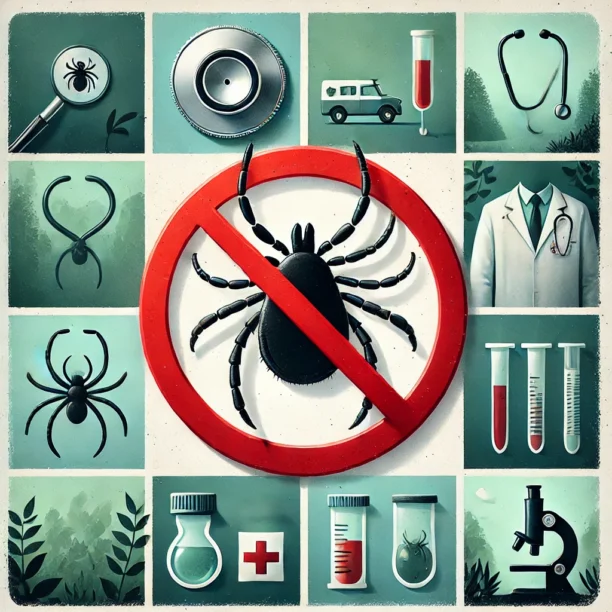Today we’re diving into a topic that’s been causing quite a stir—can Lyme disease be sexually transmitted?
If you’ve ever wondered about this, you’re definitely not alone. With the rise of misinformation, especially online, it’s become more important than ever to ensure that you have access to credible, science-based information to make the best decisions for your health. The truth is, understanding the facts can help you not only protect yourself and your loved ones but also prevent unnecessary panic.
In this post, I’m going to walk you through what the science says about Lyme disease, its transmission methods, and why myths about sexual transmission persist, even when the evidence doesn’t support them.
By the end of this, you’ll have a clear understanding of the risks, and more importantly, what steps you can take to stay healthy and informed.
The Science Behind Lyme Disease Transmission
We all know that Lyme disease is primarily transmitted through tick bites. The bacterium that causes Lyme disease, Borrelia burgdorferi, is spread via the bite of infected black-legged ticks, also known as deer ticks. These little critters are the main culprits when it comes to Lyme transmission, and they can be found in wooded and grassy areas, particularly in the northeastern and upper Midwestern United States.
But recently, there’s been growing concern—and confusion—around whether Lyme disease could also be spread through sexual contact. Some studies have found Borrelia DNA in genital secretions like semen and vaginal fluids, and this has understandably raised some eyebrows. After all, if a bacterium can be present in these fluids, doesn’t it make sense to assume that Lyme could be sexually transmitted?
It’s a fair question, and it’s one that’s been heavily debated in the medical community.
The Truth About the Research
Let’s break this down: Borrelia is similar to the bacterium that causes syphilis, which is a sexually transmitted infection (STI). And yes, there have been animal studies that suggest Borrelia can be transmitted sexually between animals. But—and this is a big but—there’s no definitive evidence that Lyme can be sexually transmitted between humans.
For decades, researchers have tried to confirm whether this is possible in humans, but so far, the results are inconclusive. The CDC and other health authorities, including ILADS and gurus in the chronic Lyme field, still maintain that tick bites are the primary mode of transmission for Lyme disease. So while the idea of sexual transmission is theoretically possible, we just don’t have the scientific backing to consider it a significant concern right now.
Why This Matters: Panic vs. Prevention
Why is this distinction so important? Because panic without proof can lead to unnecessary fear and confusion. The reality is that tick bites are still the number one way Lyme disease spreads, and that’s where our focus should remain. We need to educate people on preventing tick bites, rather than fueling fear about transmission methods that haven’t been proven in humans.
It’s important to stick to what we know, and what we know is that avoiding tick bites is your best bet for preventing Lyme disease. This means wearing protective clothing, using insect repellent, checking for ticks after spending time outdoors, and removing them properly if you find one.
The Dangers of Misinformation: Over-Treatment and Stigma
Now, let’s address a larger issue that arises from these types of misconceptions—misinformation. Misinformation can cause people to seek out treatments that aren’t necessary or, worse, undergo therapies that could actually harm them. We’ve seen this happen in other areas of medicine, and Lyme disease is no exception.
One of the biggest challenges I see in my practice is when patients come in with fears driven by myths. For example, some believe that Lyme disease can be transmitted through mosquitoes. This is completely false. While mosquitoes can harbor Borrelia for a short time, they don’t have the biological mechanism to transmit it to humans. The same goes for sexual transmission—it’s a topic that’s been blown out of proportion by well-meaning but misinformed sources.
When people believe these myths, they may demand unnecessary tests or treatments. Over-treatment is a big issue, especially when it comes to antibiotics. While antibiotics are essential for treating Lyme disease when it’s necessary, they come with risks. Overusing antibiotics can lead to potentially harmful side effects.
We must remember that more treatment isn’t always better. Just because someone tests positive for Lyme doesn’t mean they should automatically undergo treatment, especially if they’re not showing any symptoms. Treating asymptomatic patients can do more harm than good, leading to side effects that weren’t even necessary in the first place.
Lyme Disease: A Clinical Diagnosis
Another challenge we face in Lyme disease management is its clinical diagnosis. Lyme disease is primarily diagnosed based on symptoms, not just lab results. While lab tests can support a diagnosis, they’re not foolproof. Lyme disease is tricky—it doesn’t always show up on tests, and people can test positive without having any symptoms.
So, what happens when someone has a positive Lyme test but no symptoms? Should we treat them, or should we wait? This is a tough question, and one that we face often. On the one hand, not treating someone who tests positive can seem risky—what if the disease flares up later? But on the other hand, treating someone unnecessarily can cause more problems than it solves.
As a healthcare provider, my approach is to focus on what the science tells us, and that’s to treat when there are clear symptoms of Lyme disease. This helps us avoid the risks of over-treatment and focus on providing care where it’s truly needed.
The Emotional Toll of Misinformation
There’s another, often overlooked, consequence of misinformation—the emotional toll it takes on people living with Lyme disease. When myths and unproven theories are spread, it can create a sense of isolation and fear. People with Lyme disease may worry about passing the illness to loved ones through casual contact or sexual relations, even when the evidence doesn’t support these fears.
This can lead to unnecessary stigma, making patients feel even more isolated and disconnected from their support systems. Lyme disease is hard enough to manage without adding the burden of unfounded fears.
One of the greatest challenges people with Lyme face is feeling separated from others. Whether it’s due to the symptoms themselves or the fear of transmitting the disease, this sense of isolation can make the healing process even harder. It’s crucial that we focus on the facts to avoid further marginalizing those who are already suffering.
The Bottom Line: Stick to Proven Science
At the end of the day, here’s what you need to know: while the idea of Lyme disease being sexually transmitted is intriguing, the evidence just doesn’t support it as a significant concern at this time.
Does this mean it’s impossible? Maybe not, but for now, the best science we have tells us to focus on avoiding tick bites and seeking treatment when symptoms arise. This is where the real threat lies, and this is where our prevention efforts should be directed.
What You Can Do: Protect Yourself and Stay Informed
Here’s what I recommend:
- Protect yourself from tick bites: When spending time outdoors, use insect repellent, spray your shoes and socks with permethrin and do regular tick checks.
- Stay informed: Misinformation is rampant, and it’s important to rely on credible, science-backed sources when making health decisions.
- Don’t let fear guide your actions: Focus on what’s proven. The best way to protect yourself from Lyme disease is to avoid tick bites and seek early treatment if you suspect you’ve been infected.
Lyme disease is already challenging enough without the added burden of misinformation. By staying focused on the facts, we can ensure that those who need care get it, and that unnecessary fear doesn’t lead to harmful actions.
If you want to stay up-to-date on the latest Lyme disease research and get accurate, actionable information, don’t forget to subscribe to my blog. I’m committed to giving you the truth, even if it’s not always what you want to hear. And remember, I’ll be the first to tell you if the science changes, because in medicine, we’re always learning more.
Until next time, stay healthy, stay informed, and take care of yourself!



